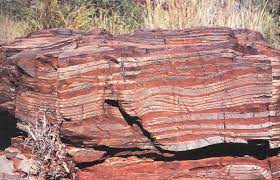Module 4 - Ecosystem Dynamics
Definitions
Anthropogenic impacts: the impact of humans, either directly or
indirectly (anthro- human).
Population Dynamics
insert notes here at some point
Past Ecosystems
Inquiry Question: How do selection pressures within an ecosystem influence evolutionary change?
Human Documentary Records
Over time, humans have recorded details and impressions of their interactions with the surrounding environments, and their religious beliefs. Examples of this include European Paleolithic Humans, with Lascaux cave art in France and Hohle Fels cave art in Germany, and Aboriginal art work, which is the longest unbroken art tradition and a primary source of the changes to Australian environments.
The West Kimberly Paintings (Wandjina and Bradshaw) and Keep River Rock Art
The Wandjina paintings are dated at 50,000-60,000 years old via radiometric dating methods. This tells us when people arrived in the area, the environment at the time, how they lived and adjusted and changes to the local landscape, flora and fauna.
The Bradshaw paintings are approximately 40,000 years old, via relative dating methods. They include images of humans with extinct megafauna and thylacine, and the types and numbers of animals shown have changed over time.
The Keep River rock art in the Northern Territory (NT) depicts four distinct changes in the types of animals, and most recently depicts the highest percentage of reptiles, implying an increase in wetlands.
| Time (approx.) | Interpreted Climate Features |
|---|---|
| 40,000 years ago | open, tropical forests |
| 10,000 years ago | cooling period and decrease in rainfall, open scrub and grassland |
| <10,00 years ago | summer monsoon climate, drought is depicted when there is no monsoon. |
Geological Dating
Geological Evidence
Changes in geological and fossil deposits can be linked to evolutionary changes in ecosystems, for example, volcanic activity may be linked to environmental factors like atmospheric or temperature changes.
Palaeontology
Fossils provide information on past climates and ecosystems. Some species of crocodile are only found in warm and humid environments, for example. There are also some marine animals that are only found in cool water, and there are some only found in oceans that have been in fossils found inland. Fossils are found in sedimentary rocks, as they typically form in water, as layers of sediment are deposited.
Geochemical
Banded iron formations in sediments consist of alternating bands of iron-rich and iron-poor sediments. This reflects changes in aerobic and anaerobic environments and fluctuations in the populations of photosynthetic cyanobacteria.

Radiometric Dating
Radiometric dating is an absolute dating method, which means it gives an actual age (in years) for an object (within a margin of error). This uses radioactive elements that occur naturally in various types of minerals and organic matter. There are several types of radiometric dating, including radiocarbon, potassium-argon, uranium-lead and cosmogenic isotope dating.
Radiocarbon Dating
Radiocarbon dating is used to measure the age of organic matter. This is possible because organisms absorb and acquire radioactive carbon through photosynthesis or through food sources, and the rate of decay is predictable, through Carbon-14 half-life.
Potassium-Argon Dating
Potassium-Argon dating measures the age of volcanic rock and ash, via the proportion of Argon-40 and Potassium-40. The object is given an approximate date, by dating the volcanic layers above and below the object.
Ice Cores
Ice cores provide information through frozen water isotopes, impurities and bubbles. Microorganisms can also be extracted. and determine periods of warming and cooling. Events are compared to other types of climate records that have independent methods, like tree rings and sedimentary rocks. Analysis of an ice core is only useful if the ages of the ice layers are known. To analyse ice cores, they are cut into sections.
Frozen Water
Heavy isotopes of hydrogen and oxygen exist in oceanic water. When water is transported as vapour to polar regions, the ratio of heavy isotopes changes. Measuring these can be used to infer temperatures when the snow originally fell. Thin sections by microtome and polarising microscopy can be used to view ice crystallisation. To analyse isotopes, mass spectroscopy can be used.
Impurities
Snow fall in remote areas like Antarctica is almost pure, with only traces of dust, salt, pollutants, volcanic activity, bushfires and pollen, all of which can be used to detect major environmental changes and variation in chemistry and circulation of the atmosphere. These can be compared to known volcanic eruptions for dating. Continuous Flow Analysis and Stratigraphy can be used to find this.
Bubbles
Air trapped in compact snow no longer interacts with the atmosphere, which means they act as atmospheric time capsules. They show changes in past atmosphere, which allows for comparison with current climate conditions. Gas chromatography and mass spectroscopy can be used to find these.
Evolution of Organisms in Australia
Main points to consider:
- Gondwanan ancestry
- Isolation of Australia when the continents
moved away from each other - Changes in sea levels affect level of access
- Changes in climate:
- Change between hot and cold
- Changes in rainfall (drying out of the
continent) - Changes in fire patterns (due to changes
in rainfall)
Reasons for changes in past ecosystems
Main points to consider:
Human impacts
Predation
Land clearing
Introduced species
Again, changes in climate:
- Change between hot and cold
- Changes in rainfall (drying out of
the continent) - Changes in fire patterns (due to
changes in rainfall)
Future Ecosystems
Inquiry question: How can human activity impact on an ecosystem?